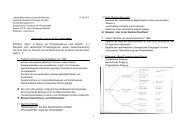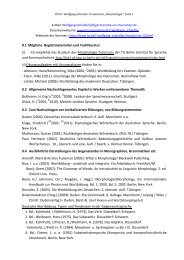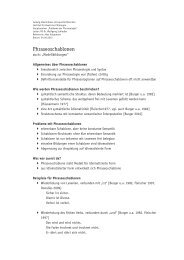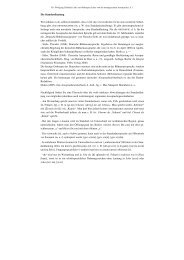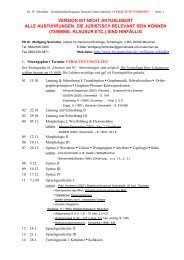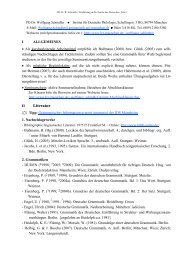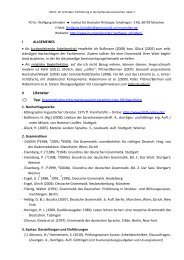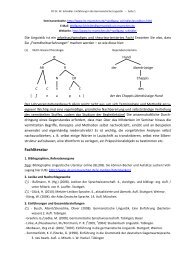Chapter 18 Lexical Functions: Description of Lexical Relations in a ...
Chapter 18 Lexical Functions: Description of Lexical Relations in a ...
Chapter 18 Lexical Functions: Description of Lexical Relations in a ...
Create successful ePaper yourself
Turn your PDF publications into a flip-book with our unique Google optimized e-Paper software.
(17)<br />
(year)<br />
(<strong>in</strong>clude)<br />
1 2<br />
—<strong>Chapter</strong> <strong>18</strong>. <strong>Lexical</strong> <strong>Functions</strong>— 89<br />
1<br />
(366)<br />
(day)<br />
YEAR<br />
! ATTR<br />
LEAP<br />
The mean<strong>in</strong>g (that <strong>in</strong>cludes 366 days) is specified <strong>in</strong> the lexical entry for YEAR as a non-standard<br />
LF with the value LEAP:<br />
YEAR<br />
…<br />
that has 366 days : leap<br />
This non-standard LF allows for the transition SemS ⇒ DSynt <strong>in</strong> (17); as a result, the LU LEAP<br />
appears <strong>in</strong> the correspond<strong>in</strong>g DSyntS.<br />
6.4 Universality <strong>of</strong> LFs<br />
One <strong>of</strong> the most important features <strong>of</strong> LFs is their l<strong>in</strong>guistic universality: they can be used to<br />
describe both semantic derivation and restricted lexical cooccurrence (= collocations) <strong>in</strong> any<br />
human language. Interest<strong>in</strong>gly, they correspond to mean<strong>in</strong>gs that receive special treatment <strong>in</strong><br />
natural language: to what is called grammatical mean<strong>in</strong>gs, i.e., <strong>in</strong>flectional and/or<br />
derivational mean<strong>in</strong>gs (grammemes and derivatemes). Thus, the LFs provide lexical<br />
expressions for mean<strong>in</strong>gs out <strong>of</strong> a ‘privileged’ set, which under different circumstances are<br />
expressed morphologically. I cannot go <strong>in</strong>to greater detail here, but I th<strong>in</strong>k that it could be useful<br />
to illustrate LFs <strong>in</strong> languages other than English. Therefore, I present below some examples taken<br />
from thirteen different languages.<br />
1. English<br />
Magn(ra<strong>in</strong>) = heavy<br />
Magn(argument) = conv<strong>in</strong>c<strong>in</strong>g, strong, weighty,<br />
Oper1(trip) Oper1(deal) = take [ART ~]<br />
= strike [ART ~]<br />
< knock-down<br />
Magn(applause) = thunderous, deafen<strong>in</strong>g, boisterous,<br />
whirl-w<strong>in</strong>d, …<br />
Oper1(apologies) = <strong>of</strong>fer [~s]<br />
Magn(resistance) = dogged, ferocious, fierce, stiff, ... Oper1(resistance) = <strong>of</strong>fer, put up [~]<br />
2. French<br />
Magn(pluie (ra<strong>in</strong>)) = forte (strong), violente (violent)<br />
< torrentielle (torrential)) Oper 1(voyage (trip)) = effectuer (carry out),<br />
faire (make) [ART ~]<br />
Magn(argument (argument)) = fort (strong),<br />
conva<strong>in</strong>cant (conv<strong>in</strong>c<strong>in</strong>g), massue lit. (club) Oper 1(accord (deal)) = arriver (arrive), parvenir<br />
(achieve) [à ART ~]


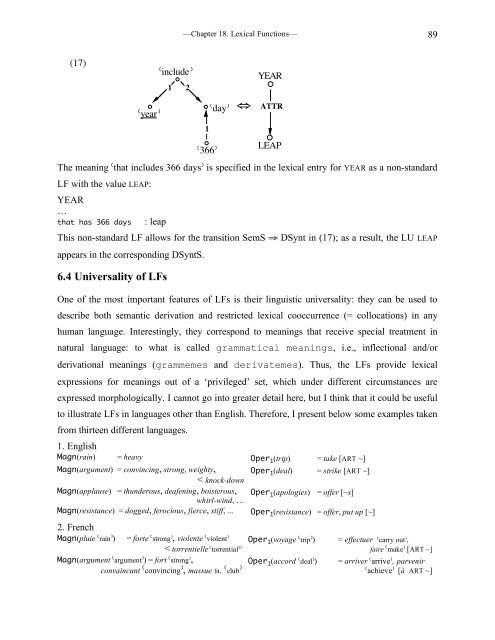
![E-Mail: Wolfgang.Schindler[ätt]germanistik.uni-muenchen.de Web ...](https://img.yumpu.com/51590147/1/184x260/e-mail-wolfgangschindlerattgermanistikuni-muenchende-web-.jpg?quality=85)
